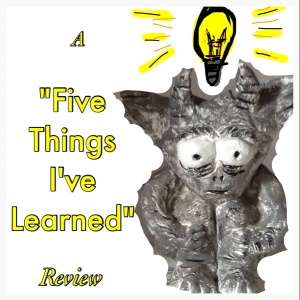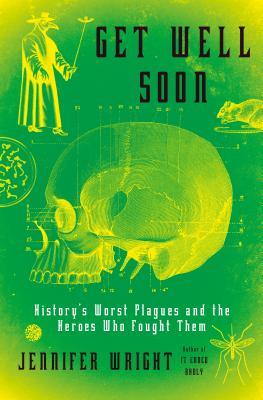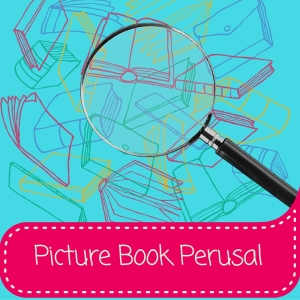
.aaaaand a Top Book of 2017 Pick!

Today’s book is all about death and disease and as such, you wouldn’t necessarily think it would be all that enjoyable to read. You would, however, be wrong. Get Well Soon: History’s Worst Plagues and the Heroes Who Fought Them by Jennifer Wright is a massively accessible nonfiction book with a conversational tone and enough humour to keep the (in some places) quite terrifying content, readable. Here’s the blurb from Goodreads:
A humorous book about history’s worst plagues—from the Antonine Plague, to leprosy, to polio—and the heroes who fought them
In 1518, in a small town in France, Frau Troffea began dancing and didn’t stop. She danced herself to her death six days later, and soon thirty-four more villagers joined her. Then more. In a month more than 400 people had died from the mysterious dancing plague. In late-nineteenth-century England an eccentric gentleman founded the No Nose Club in his gracious townhome—a social club for those who had lost their noses, and other body parts, to the plague of syphilis for which there was then no cure. And in turn-of-the-century New York, an Irish cook caused two lethal outbreaks of typhoid fever, a case that transformed her into the notorious Typhoid Mary and led to historic medical breakthroughs.
Throughout time, humans have been terrified and fascinated by the plagues they’ve suffered from. Get Well Soon delivers the gruesome, morbid details of some of the worst plagues in human history, as well as stories of the heroic figures who fought to ease their suffering. With her signature mix of in-depth research and upbeat storytelling, and not a little dark humor, Jennifer Wright explores history’s most gripping and deadly outbreaks.
And here are Five Things I’ve Learned From Get Well Soon: History’s Worst Plagues and the Heroes Who Fought Them by Jennifer Wright:
1. The incredibly deadly Spanish Flu didn’t actually originate in Spain.
2. No matter what the disease, it never does anyone any good when a stigma is attached to those who carry it.
3. Having a plague that makes you dance non-stop for hours (or days) at a time may sound like fun, until your bones start protruding through your skin just as “Blame it on the Boogie” comes on.
4. Indulging in an illicit romp with a lady of the night is all fun and games until your nose (and probably hers also) falls off.
5. People actually queued up at one time in history to allow a madman to drill holes in their skulls, in the hope that it would provide a cure for their assorted maladies.
I can’t remember when I last giggled so much while reading about infectious disease as I did while reading this book. In terms of making nonfiction books accessible, Wright has done a bang-up job here with a narrative style that is light – but never makes light – despite content that can result in some pretty sobering reading. The humour in this book is almost a necessary vent for the anger and sadness and bafflement some readers may experience while finding out about the ways in which some very sick people – as well as the people who tried to help them – were treated at various points throughout history.
The book covers various plagues in separate sections and includes famous plagues, such as the Black Death, Spanish Influenza, and Polio, alongside lesser known ailments such as the dancing plague mentioned in the blurb, the “plague” of lobotomies orchestrated by William Jackson Freeman III and the plague of Encephalitis Lethargia, which results in the loss of any kind of emotion or motivation and leaves sufferers, in some cases, like living corpses. Part of the focus of the book is on how authorities and others dealt with these diseases when they first appeared and how this action or inaction affected the disease’s spread. It’s fascinating to see how the work of some individuals and groups to gain evidence for the causes of certain diseases – cholera being a case in point – was pooh-poohed (pardon the pun) by the authorities and scientific community even in the face of growing numbers of people contracting the disease.
I suspect this book won’t necessarily cut it for those hoping for a scientific look at plagues and their causes, but for the casual reader and those interested in social responses to medical disasters, the book will provide enough information to be going on with. The style of writing feels like narrative nonfiction, in part because of the way in which the author has highlighted the individuals involved in the outbreaks of each specific disease. While the use of the term “heroes” to describe these people feels a bit twee to me, I appreciate the fact that these people should be acknowledged and possibly lauded as household names more than they usually are.
My favourite part of the book was the section dealing with Spanish influenza, simply because of the dastardly bad timing that meant this disease came to prominence at the same time as World War 1, leading to catastrophic breakdowns in communication between authorities and the general public that, had this been different, could have saved many lives. Looking back on the content, I was mildly disappointed that the Ebola virus was not included in the list of diseases, but I suppose you can’t have everything.
If you, like me, enjoy reading about major global disasters in a style that won’t freak you out too badly or exacerbate general feelings of anxiety about the state of the world, this would definitely be one to add to your TBR.
Oh, and I’m adding this to my Colour Coded Challenge as well. Check out my progress here.
Until next time,
Bruce




















